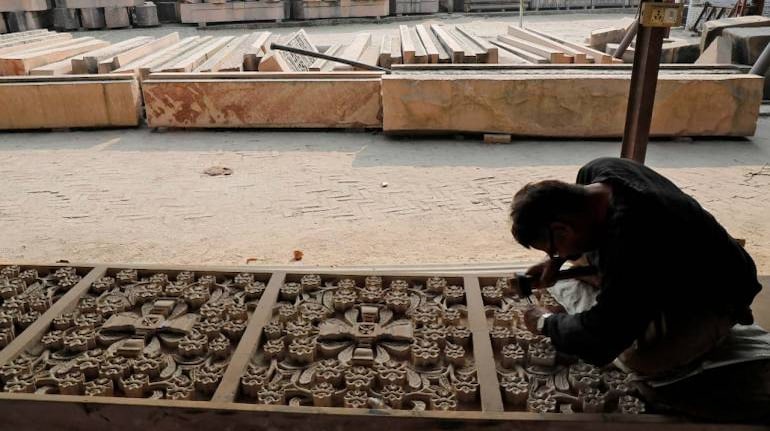
When Prime Minister Narendra Modi will lay the foundation stone of the Ram temple in Ayodhya on August 5, along with millions of devotees, real estate players, too, will be watching the proceedings, hoping for a start in a town that holds a lot of promise for them.
Studio apartments, 1-BHK flats, second houses and starred hotels are what developers have planned for this small dusty town in Uttar Pradesh’s Faizabad district that had been a battleground of faiths for decades till the Supreme Court settled the bitter land dispute in 2019.
“We would be keen to launch service apartments and second homes in this city,” Manoj Gaur, managing director of the Gaurs Group, told Moneycontrol over the phone. “This town presents immense opportunities.”
The price of farmland has gone up more than 30 percent since the Supreme Court order, developers scouting for real estate parcels told Moneycontrol.
“An agricultural land parcel spread across an acre was available for Rs 75 lakh to Rs 1 crore before the SC order. Currently, the asking price is Rs 1.25 to Rs 1.50 crore per acre, depending on the location. Most of these are located 10 to 15 km from the temple site,” Shobhik Goyyal, member, Credai UP, and promoter of OP Chains Housings, which conducted a survey of the area, told Moneycontrol.
The top court ordered that the disputed site be given to Hindus to build a Ram temple and Muslims be allotted another piece of land to build a mosque.
Gaur and other builders are now waiting for Ayodhya’s Master Plan 2031.
““Ayodhya is in the limelight and we are in talks with the government through bodies such as PHDCCI and Credai,” Gaur said. Credai is an all-India lobby group of real estate developers.
Ayodhya is among the towns to be developed under the Atal Mission for Rejuvenation and Urban Transformation (AMRUT) that aims to provide basic amenities like water, sewerage and transport aimed at changing the face of urban India.
“The National Remote Sensing Centre has been tasked with providing satellite imagery of the town. The team is working on it. The draft plan is likely to be ready by September 2020 and the final Master Plan of Ayodhya 2031 is expected to be ready by January 2021,” Anoop Shrivastava, Chief Town and Country Planner, told Moneycontrol over the phone.
A master plan outlines developmental works expected to be carried out in an area. It demarcates land use—for residential and commercial purposes, including for hotels that Ayodhya will need in large numbers for pilgrims and workers involved in building the temple. Most of the land available right now is agricultural.
Unlike other asset classes, housing projects in holy cities have largely escaped the slowdown and the coronavirus outbreak unscathed.
Retirees or NRIs, who may want wish to spend a few months at the birthplace of Ram, will be among top property buyers in the town, say realtors.
Ayodhya has the potential to emerge as an ideal market for second homes or retirement homes.
Developers have launched several projects in holy cities such as Amritsar, Haridwar-Rishikesh, the four Hindu Dhams of Badrinath, Dwarka, Puri and Rameswaram and in South Indian temple towns of Madurai and Tirupati.
Ramandeep Singh, Alliance Residency Ltd, Credai, UP, said there was a dearth of organised real estate projects in the area. “There may also be demand from the workforce that comes to work in this area going forward besides demand for pilgrimage housing. Most of the land right now is held by the Akharas.” Akharas are Hindu monastic groups.
Also, most of the agricultural land parcels are 10 to 15 km away from the temple site. “Two five-star hotels have already been signed up. We are hoping that five more would come up in the area besides 20 odd three to 4-star hotels,” said Goyyal of Credai UP.
Once the Master Plan is in place, developers foresee a demand for studio apartments or 1-BHK units.
“In the next five to seven years, one may see demand for at least 5,000 units in the range of Rs 15 lakh to Rs 30 lakh in this area, with maximum demand coming in from devotees. More than 15 developers have already shown interest,” he said.
The town would also need a massive infrastructure upgrade, said Shobhit Dass, president, Credai, UP. “There is not a single branded hotel in the area, only dharmshalas. Senior living housing could also come up in this area,” he said.
“We are all waiting for the master plan to be ready and once it is in place, the entire area is expected to be opened up for development,” he adds.
Discover the latest business news, Sensex, and Nifty updates. Obtain Personal Finance insights, tax queries, and expert opinions on Moneycontrol or download the Moneycontrol App to stay updated!